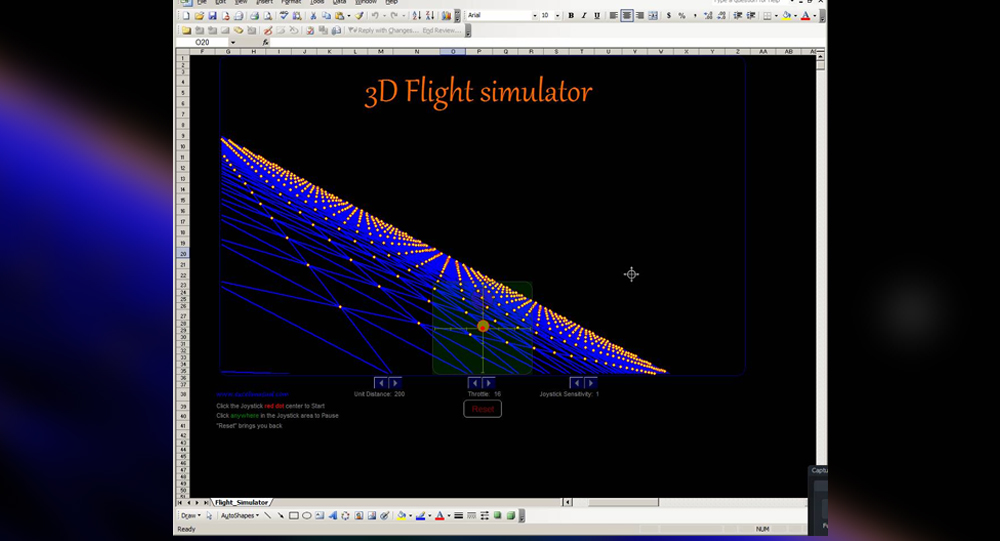
In the late 1990s, Microsoft Excel 97 was a powerhouse productivity tool shaping the workplace, known primarily for its ability to manage numbers, create charts, and automate calculations. However, beneath its professional surface lay an extraordinary secret—a hidden flight simulator game cleverly disguised inside the software.
This wasn’t a typical Easter egg joke or a simple graphic. The flight simulator in Excel 97 functioned as a complete 3D game, fully interactive and surprisingly complex, running entirely within the ancient spreadsheet environment. For many users, discovering this hidden gem was a flight experience unlike any other.
How the Flight Simulator Was Conceived and Hidden
The hidden flight simulator came from the creativity of a Microsoft developer, known internally as John Walker, who was inspired by earlier flight sims and an affinity for pushing Excel’s capabilities beyond expectations. Using only the available spreadsheet macros, VBA (Visual Basic for Applications), and ingenious use of graphical tricks with cells and formulas, Walker built a rudimentary but fully playable simulatio
The game allowed a player to “fly” a plane through a flat spreadsheet “sky,” maneuvering via keyboard inputs to avoid obstacles, change altitude, and test navigation skills. The clever use of Excel cells displayed the runway and sky, giving the impression of altitude and distance despite the program’s 2D spreadsheet layout.
Installing the game wasn’t an obvious reveal—users needed to follow a specific series of commands or open hidden worksheets to unlock the flight simulator, maintaining its mystique and enhancing its allure.
Gameplay Mechanics and User Experience
Flying inside Excel 97 was a novel experience. Players used arrow keys to direct a pixelated triangular “plane” above an abstracted landscape made up of grids. Controls included adjusting plane pitch and direction, simulating the feel of flight dynamics within tight technical constraints.
Despite Excel’s limitations, the game featured wind effects, altitude adjustments, and a simple scoring system rewarding smooth landings and obstacle avoidance. Compared to modern flight sims, it was basic, but the experience of piloting imagined skies through cells fascinated both tech enthusiasts and casual users alike.
The game exemplified how software could contain hidden surprises that sparked curiosity, stepping away from dry, business-focused image equation tools to playful interactive entertainment.
Why the Flight Simulator Easter Egg Matters Today
Though Microsoft discontinued Excel’s Easter eggs in subsequent versions for security reasons, the Excel 97 flight simulator remains a beloved legend in software folklore. It reflects a time when software engineers inserted personality and fun into their work, challenging norms around productivity software.
This hidden gem also reminds us that innovation often blooms in unlikely places—with creative skill and technical resourcefulness turning routine tools into portals of wonder and exploration.
Fascinating Trivia About the Excel 97 Flight Simulator
- The flight simulator was accessible only in the Windows version of Excel 97; Mac users missed out.
- This was not an officially advertised feature but rather an internal joke and gift from developers to users.
- Excel’s VBA macro language was pivotal in creating the game’s interactive elements, showcasing early scripting power in office software.
- The plane’s design is a simple triangle icon, making the software interface function dually as a game viewport and tool.
- Similar secret games existed in other Microsoft products, including hidden pinball and racing games, but Excel’s flight sim is unique for its complexity.
- Discovery stories often involve users stumbling on the game by accident or following obscure online instructions published years after release.
- The game contributed to the broader cultural phenomenon of software Easter eggs, celebrated by programmers and users alike.
Final Thoughts: Flying High on Hidden Pixels and Software Ingenuity
The Excel 97 flight simulator game teaches us that even the most serious, number-crunching applications can hold secrets that delight and engage. It’s a testament to the creativity inside the tech community and a cherished piece of software history that redefined what an office program could be.
Whether you’re a flight sim enthusiast, a Microsoft nostalgist, or a lover of digital Easter eggs, the tale of Excel’s sky-high secret offers a fascinating glimpse into the playful artistry behind everyday software.
If this journey through the hidden skies of Excel 97 inspired you, share it to celebrate the quirky brilliance of software creators and the enduring culture of hidden digital treasures.
Sources & Further Reading:
- BBC News Archive: Software Easter Eggs and their Legacy
- Smithsonian Magazine: Hidden Games in Microsoft Office
- Tech Insider: The Secret Flight Simulator inside Excel 97
- Microsoft Developer Stories: VBA and Office Easter Eggs
- Reddit and User Forums: Discovering the Excel Flight Simulator
These sources provide deeper insights into the technical, historical, and cultural significance of the Excel 97 flight simulator and software Easter eggs in general.

How a Man Fooled Florida with Fake Penguin Tracks for 10 Years
In 1948, Florida’s Clearwater Beach was the stage for one of the longest-running and most peculiar hoaxes in American folklore. Giant three-toed footprints appeared mysteriously in the sand, sparking rumor and fascination about a 15-foot-tall penguin roaming the shores. For a decade, locals and visitors alike speculated and scanned for the elusive creature, never realizing the truth: these tracks were made by a man wearing 30-pound lead shoes designed to imitate an enormous penguin's footprint. This article uncovers the details of this elaborate prank and its lasting legacy in Florida’s cryptic history.

The mysterious Pumpkin impaled on the top of Tower
Twenty Three years ago, somebody impaled a 60-pound pumpkin 170 off the ground on this spire at Cornell University. Nobody knows who did this or how they did it.

Nevada’s Fly Geyser Is A Surreal Wonder That Looks Like Its On Another Planet
In 1964, an energy company accidentally created Nevada’s Fly Geyser after drilling into a geothermal pocket. Since then, the geyser has been releasing algae-filled scalding water five feet in the air, depositing minerals and forming a cone that sports vibrant hues of green and red.

The Miracle Baby: Nigerian Couple in the UK Welcomes a Rare Blonde, Blue-Eyed Child
A black, Nigerian couple living in the U.K. gave birth to a white, blonde, blue-eyed baby that they call the "miracle baby."

Thousands of Rare "Ice Eggs" Blanket Finnish Beach in Spectacular Natural Phenomenon
Thousands of ice balls recently covered a beach in Finland, a rare phenomenon caused by wind and waves sculpting pieces of ice into smooth spheres. These "ice eggs" can vary in size from chicken eggs to soccer balls and have also been spotted in other cold regions globally.

Recipient of suicide victim's heart kills himself 12 years later
In 1995, Sonny Graham received a transplanted heart from a suicide victim. He then committed suicide in the very same manner as the donor.

What Caused The Mysterious Patomskiy Crater in Siberia?
Discovered in 1949, the Patomskiy Crater resembles a huge convex cone with a funnel-shaped recess and a rounded hill in the middle, which looks like an eagle’s nest with an egg nestled inside it. The crater’s origin is a mystery that has baffled scientists for decades.

Atomic Tourism: In the 1950s, nuclear tests in Las Vegas served as a draw for tourists
Between 1950 and 1960, Las Vegas offered “Atomic Tourism” in which guests could watch atomic bombs being tested in the desert as a form of entertainment.

The “Walking” Palm, tree species can walk up to 65 feet each
This tree species can walk up to 65 feet each year to find the best habitat to live in.

Why This Belgian Bar Makes You Trade Your Shoe for a Beer
To prevent tourists from stealing their beer glasses, some bars in Belgium require people to hand over one of their shoes as a deposit which is then put in a basket and hung from the ceiling. These shoe baskets have also become an attraction.

When the Sky Rained Fish: An Unbelievable Encounter Above Alaska
A small Alaskan plane was hit by a fish falling from the sky. It had been dropped by an eagle that misjudged its grip. The plane was unharmed, but it made the news as possibly the weirdest bird strike ever.

Why Do Spiders Rain From the Sky? The Strange Ballooning Phenomenon
Every now and then, people around the world are amazed—and sometimes disturbed—to see thousands of tiny spiderlings floating down from the sky, seemingly raining on the earth below. This eerie spectacle is the result of a curious and fascinating behavior called ballooning, in which spiders use silk threads as invisible parachutes to catch the wind and fly. Recent scientific discoveries reveal that spiders can even harness Earth’s electric fields to take off without wind, making their aerial journeys feel almost supernatural. This article explores the science, mystery, and wonder behind the ballooning phenomenon.

A one-eyed Vancouver fish receives a fake eye so that other fish will not bully him
A fish whose eye was removed due to cataract was bullied by other fish at the Vancouver Aquarium. So the vets fitted the fish with a prosthetic eye to fool the other fishes.

The Story of Tsutomu Yamaguchi: The Man Who Survived Both Atomic Bombs
Tsutomu Yamaguchi’s story is one of astonishing survival and resilience. In August 1945, while on a business trip in Hiroshima, he endured the catastrophic atomic bombing and, unbelievably, survived to return to his home city of Nagasaki—only to face a second atomic attack days later. Officially recognized as the only person to survive both bombings, Yamaguchi’s life is a powerful testament to human courage, hope, and the devastating impact of nuclear warfare.

Vakil Batirshin’s Story: How Radiation Exposure Caused Severe Lymph Node Swelling
This is Vakil Batirshin, a man whose severe swelling from enlarged lymph nodes was reportedly caused by radioactive exposure. His condition highlights the devastating and long-term health effects radiation can inflict on the human body—often surfacing years after initial contact. Cases like his underscore the importance of nuclear safety and medical support.

Lucy and Maria The Biracial Twin Sisters with Rare Black and White Skin Colours
Lucy and Maria Aylmer are twins, but they have a hard time to convincing people. Even though they have mixed-raced parents, their mom was still shocked when the midwife handed her babies she’d expected to look alike, but were complete opposite.

Brazilian gang leader attempts to escape from Rio de Janeiro prison by dressing up as his daughter
In 2019, a Brazilian gang leader tried to escape from prison by dressing up as his daughter when she visited him behind bars and walking out of the penitentiary's main door in her place.

Frank Lentini, The Three-Legged Sideshow Performer
Francesco Lentini was a man with three legs, four feet, sixteen toes, and two sets of functional male genitals. He worked for the circus and lived to be 78 years old.

Mystery SOLVED: blood Rain in India
The dissemination of spores of microalgae has been identified as the origin of the 'Blood Rain' phenomena, according to a new study by Indian and Austrian experts. Since 1896, reports of intermittent red-colored rain in portions of Kerala and Sri Lanka have been coming in. The most recent one occurred in 2013 over Kerala.

The Real-Life Sleeping Beauty: A Girl with Hypersomnia Syndrome
An Indonesian 17-year old teenager Siti Raisa Miranda or Echa, has a rare medical condition formally called Kleine-Levin syndrome (KLS) where she can sleep for days and weeks without being woken up. Echa was only 13 when she first slept for a week. She’s now 17, and her parents still need to feed her and change her clothes when she experiences the deep levels of grogginess.

The mystery of India's 'lake of skeletons'
In 1942, a British forest guard in India made an alarming discovery. Some 16,000 feet above sea level, at the bottom of a small valley, was a frozen lake absolutely full of skeletons.

How a Canadian Man Traded a Red Paperclip for a Two-Story Farmhouse
In 2005, Canadian blogger and entrepreneur Kyle MacDonald embarked on an extraordinary journey that captured the world’s imagination. Starting with nothing more than a single red paperclip, Kyle pursued a year-long chain of strategic trades that escalated from small, quirky items to a two-story farmhouse in a small town in Saskatchewan. What began as a playful social experiment became a legendary story of creativity, perseverance, and the power of barter in the digital age.

This Thai Wedding Tradition Happens 40 Feet Underwater
Each year in Trang, Thailand, dozens of couples participate in an underwater wedding ceremony while scuba diving in full gear. The ritual symbolizes deep love and has become a quirky tourist attraction held around Valentine’s Day.

A woman finds her ex-boyfriend living in her attic 12 years after they broke up
Most people have heard of "things that go bump in the night," but for one South Carolina lady, that "thing" was her ex-boyfriend, whom she discovered living in her attic more than 12 years after they broke up.

Story of Peng Shuilin: Man with only half a body
We have a habit of whining in our daily lives. We never seem to be pleased with the things we have in life. "I want to be skinny," fat people say, "I want to be fat," slim people say. Poor people aspire to be wealthy, and wealthy people are never satisfied with their status. Everywhere we go, we're whining. Can you image how a man would want to live if he didn't have any legs or bums at all?


























